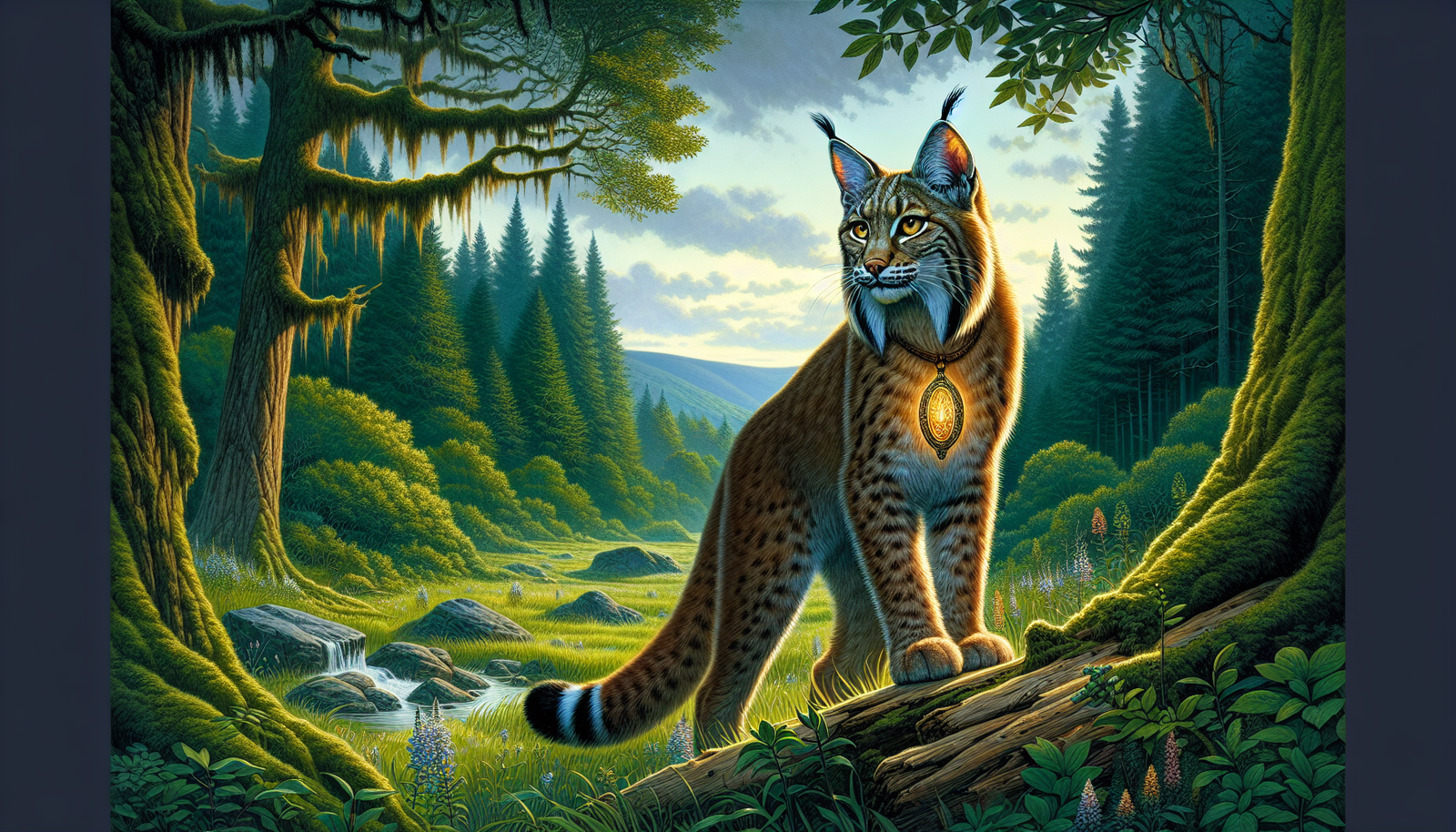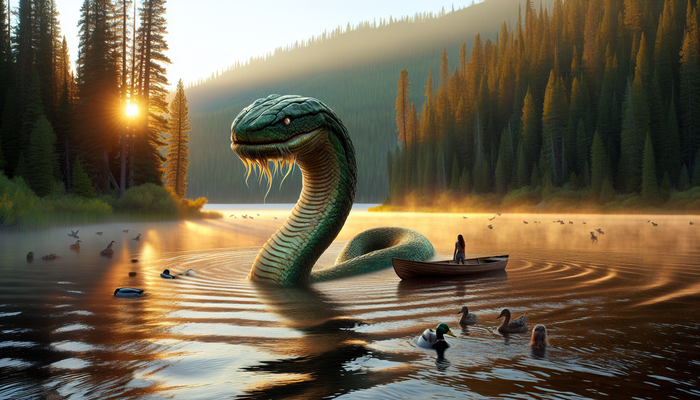Tail of Mystery: Pennsylvania's Long-Tailed Bobcats

By Lucas Jennings, Cryptozoologist and Adventurous Naturalist
Introduction
The dense forests of Pennsylvania have long harbored whispers and rumors of a peculiar creature, one that blurs the lines between known wildlife biology and the intriguing world of cryptozoology. I'm talking about the long-tailed bobcat – a cryptid feline that has captured the imagination of enthusiasts and researchers alike.
Unlike the typical bobcat known to science, with its characteristic short "bobbed" tail, sightings and reports from Pennsylvania suggest the existence of bobcats with unusually long tails. These accounts challenge established knowledge and spark debate within both the scientific and cryptozoological communities.
In this article, I'll delve into the mystery of Pennsylvania's long-tailed bobcats, exploring eyewitness accounts, scientific skepticism, and the possibility that these sightings represent genetic anomalies or even an entirely new subspecies. I'll examine the implications of these reports on local lore, conservation efforts, and the broader pursuit of understanding within my field of cryptozoology.
By balancing scientific inquiry with an open-minded exploration of the unknown, I aim to shed light on this enigmatic creature. I also hope to showcase the potential for undiscovered wonders in the natural world that exists right in Pennsylvania's own backyard.
The Bobcat: A Brief Overview
Before diving into the long-tailed mystery, let's first understand the creature that Pennsylvania's cryptid is often confused with – the standard bobcat.
The bobcat is a medium-sized wild cat native to North America, including Pennsylvania. It's characterized by its muscular build, short "bobbed" tail (about 4 to 7 inches long), and distinctive spotted patterning.
An adaptable predator, the bobcat thrives in various environments, from dense forests and swamplands to suburban areas where it remains elusive to human observation.
In Pennsylvania, the bobcat plays an important role in its ecosystem as a keystone predator. Its main prey includes rabbits, hares, squirrels, mice, and birds. Bobcats help regulate prey populations and also serve as an indicator of environmental health. Their presence reflects the ability of Pennsylvania's habitats to sustain not just these felines, but a diversity of animal life.
The Long-Tailed Mystery
Now, let's get to the heart of the matter – the mystery surrounding bobcats with anomalously long tails in Pennsylvania. Sightings and reports have surfaced over the years of bobcats boasting tails significantly longer than the 4 to 7 inch range considered typical for the species.
Some accounts describe tails upwards of 8 or 9 inches, while more dramatic reports suggest lengths surpassing a foot. These accounts contradict conventional wisdom that the "bobbed" tail is a distinguishing feature of the bobcat compared to other wild felines.
Understandably, such sightings spark debate. Do they represent a known species displaying an uncommon trait? Or could Pennsylvania be home to an entirely new, yet-to-be-discovered variant of the bobcat? The intrigue lies between verified wildlife biology and the realm of cryptozoological speculation.
Eyewitness Accounts and Confusion
A diverse array of observers claim to have encountered Pennsylvania's long-tailed mystery cats. Their accounts add fuel to the speculative fire.
Casual hikers, seasoned hunters, and knowledgeable locals alike have shared startlingly similar stories. They describe fleeting glimpses or sustained sightings of bobcats with disproportionately lengthy tails.
Naturally, these reports are tinged with confusion. The witnesses struggle to reconcile what they've seen with established knowledge about typical bobcat physiology. Some question their own eyesight, while others grow frustrated that their credibility is doubted by skeptics.
For those certain of what they've seen, the long tail is not the only distinguishing feature. Multiple accounts also describe the cryptid felines as larger than an average bobcat, with a rangy build and muscular hindquarters.
Of course, without photographic evidence, these accounts are difficult to verify. But for the observers, the experience of seeing an animal that shouldn't exist is unforgettable. Their sightings remain vividly etched in memory, regardless of others' disbelief.
Scientific Scrutiny and Speculation
Within the scientific community, reports of anomalously long-tailed bobcats are met with skepticism. Some zoologists outright dismiss the possibility of such a creature inhabiting Pennsylvania. They demand concrete evidence that eyewitness testimony simply cannot provide.
Others allow that rare genetic variations could produce bobcats with atypical features like elongated tails. However, they caution that without documentation, this remains mere speculation. No genetic study has confirmed long-tailed bobcats, though samples would be needed to make such a determination.
More open-minded scientists acknowledge that new feline species continue to be discovered worldwide. They point to the potential for an unrecognized bobcat subspecies with a long-tailed mutation as a plausible, if unproven, possibility. Still, the majority of biologists consider this unlikely without physical proof.
The lack of photographic evidence or biological samples indeed prevents the long-tailed bobcat from being acknowledged as a verified animal by science. But for Pennsylvania locals, the consistent sightings suggest something unusual is afoot in their forests.
A Cryptozoological Perspective
As a cryptozoologist, cases like the long-tailed bobcat offer tantalizing avenues of exploration. Cryptozoology occupies itself with creatures that lie beyond the boundaries of accepted zoology, relying on folklore, eyewitness accounts, and anomalous evidence to search for animals that science does not yet recognize.
Pennsylvania's long-tailed mystery cat is a perfect example. It embodies the cryptozoological spirit of inquiry and open-mindedness in the face of scientific skepticism. Approaching this case through a cryptozoological lens means considering all possibilities, no matter how remote.
Does an unknown feline prowl Pennsylvania, a rare and elusive beast recorded only in fleeting sightings and sporadic reports? Or could a mundane explanation account for the anomaly, like simple misidentification or genetic aberrations? A cryptozoologist's work is to investigate all angles without prejudice.
For enthusiasts like myself, the long-tailed bobcat invites excitement at the prospect of discovery and the allure of the unknown. Cases like this stimulate curiosity in the shadows of nature where mysteries still lurk, propelling the spirit of adventure that lies at the heart of cryptozoology.
Impact on Local Lore and Conservation
The intrigue surrounding Pennsylvania's long-tailed enigma has seeped into local lore. The cryptid felines have captured the imagination of residents and visitors, becoming part of the region's cultural fabric.
As a cryptozoologist, I appreciate how fascination with mysterious creatures can strengthen conservation efforts. By highlighting the vast and unknown facets of nature, cryptids like the long-tailed bobcats underscore the importance of preserving pristine wilderness habitats.
If such an unusual feline does roam Pennsylvania forests, it would require ample territory and intact ecosystems to remain hidden. Its potential existence serves as a powerful reminder that robust conservation is crucial for sustaining both rare wildlife and healthy natural environments.
The promise of undiscovered species can inspire passion for protecting habitat, even from those who otherwise feel disconnected from nature. To me, that's one of the greatest values of creatures like the long-tailed bobcat, real or imagined. Their mystery drives home what could be lost if wilderness is not conserved.
In Search of Evidence
Of course, the long-tailed bobcat's existence remains speculative without definitive evidence. As a researcher, I'm eager to deploy tools like trail cameras, DNA analysis, and extensive field studies to solve this zoological riddle.
Technology has vastly expanded the scope of what cryptozoologists can investigate. Camera traps, in particular, are a promising avenue for capturing photographic proof if long-tailed bobcats do roam Pennsylvania. Genetic testing could also identify anomalies that might account for this trait.
Meticulous, open-minded field research is critical too. We must be willing to spend long hours observing these felines' potential habitats to track patterns of behavior that could illuminate how a long-tailed variant may live.
Public assistance is invaluable for cryptozoological work, and I encourage anyone with potential evidence or sightings to come forward. Every report provides a valuable data point, bringing us closer to determining if a distinct long-tailed subspecies could inhabit Pennsylvania.
Balancing Skepticism and Open-Mindedness
In investigating cases like the long-tailed bobcat, I strive for a balance of scientific rigor and open-minded exploration. As a zoologist, I understand the importance of concrete proof and empirical evidence that my cryptozoological peers sometimes overlook.
But I also recognize the limitations of conventional science. New species continue to be identified, even in well-studied regions. Rare or elusive animals can evade detection for decades before entering the annals of formal zoology. An open mind is key.
Productive collaboration requires meeting in the middle. Scientists must overcome knee-jerk dismissals of cryptozoological possibilities and be willing to pursue unconventional avenues. Cryptozoologists, in turn, need to adopt more systematic methods and exercise judicious skepticism about fantastic claims.
With open communication and good faith on both sides, I believe cryptozoology and mainstream biology can work synergistically to expand the boundaries of known wildlife. The long-tailed bobcat offers the perfect opportunity to put this collaborative spirit into practice.
Final Thoughts
In the end, the long-tailed bobcats of Pennsylvania remain shrouded in mystery. Their existence is far from proven, yet consistent eyewitness reports suggest these cryptid felines prowl the state's remote forests.
Beyond this specific case, the saga highlights important themes in my work as a cryptozoologist. It exemplifies the enduring allure of nature's secrets, our human drive to illuminate the unknown, and the interplay between folklore, eyewitness testimony, and biological fact in tracing the contours of zoological reality.
Most of all, it's a call to action. A reminder that discovery requires open-minded initiative. There are wonders waiting in the wilds of Pennsylvania and beyond, hidden just out of sight. But they cannot reveal themselves without our curiosity to seek them out.
So join me on this quest to unravel the enigma of Pennsylvania's long-tailed bobcats. Share your sightings, contribute evidence, and help conserve the wilderness habitats where such creatures might dwell. Most importantly, nurture your sense of wonder. If we lose that, we lose our connection to the natural world and all its splendor. Amidst the mysteries that still abound, wonder may be our most valuable compass guiding the way.
From Bigfoot to UFOs: Hangar 1 Publishing Has You Covered!
Explore Untold Stories: Venture into the world of UFOs, cryptids, Bigfoot, and beyond. Every story is a journey into the extraordinary.
Immersive Book Technology: Experience real videos, sights, and sounds within our books. Its not just reading; its an adventure.



























